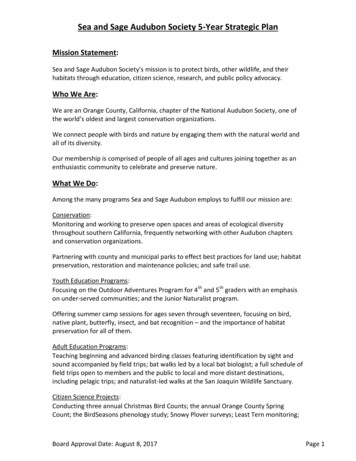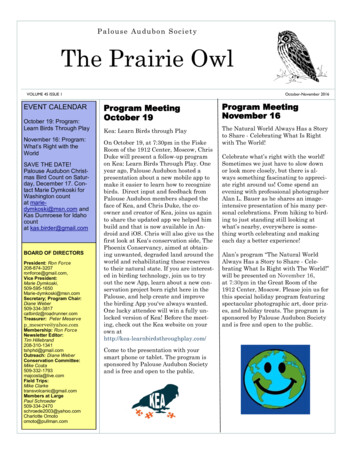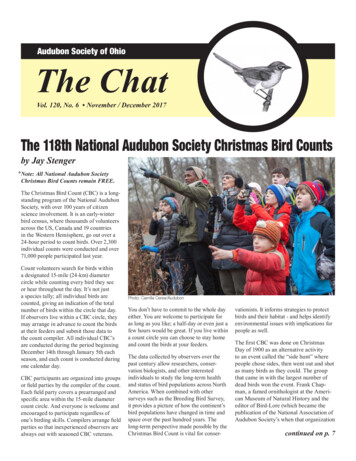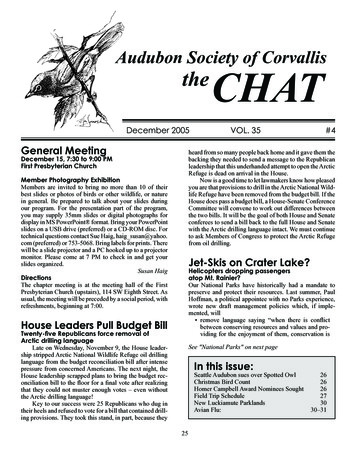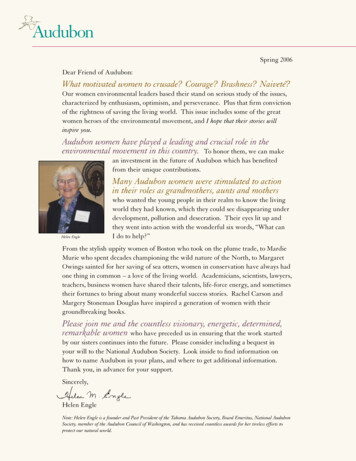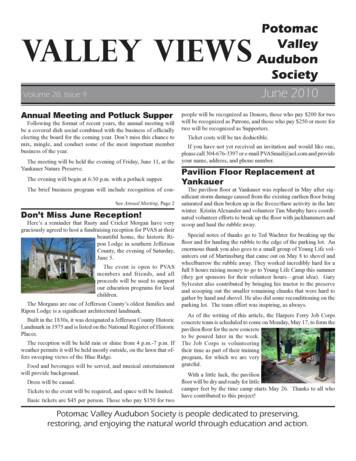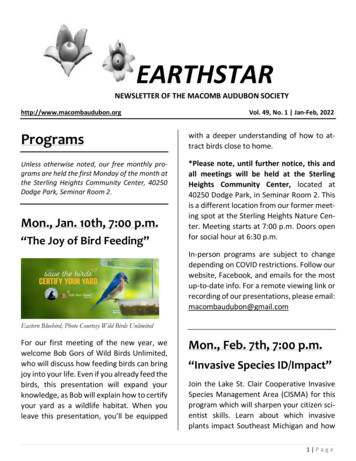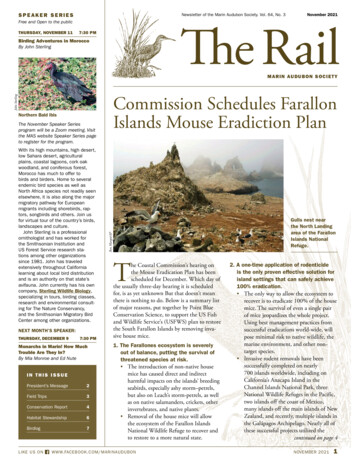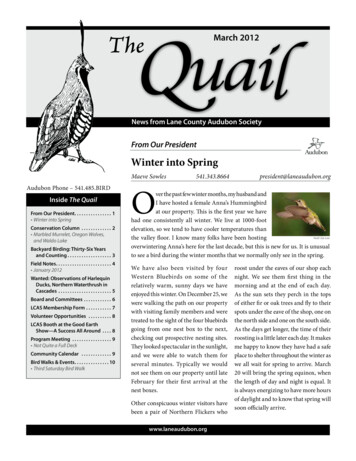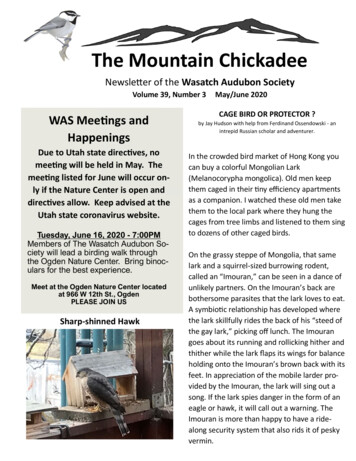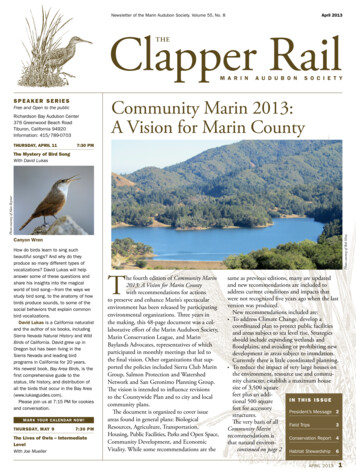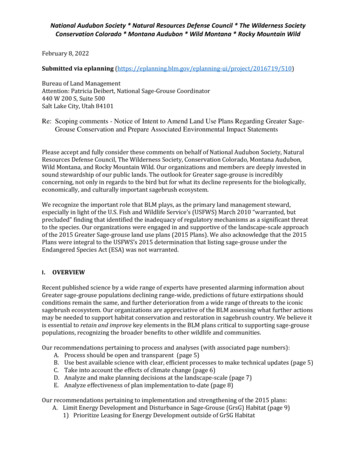
Transcription
National Audubon Society * Natural Resources Defense Council * The Wilderness SocietyConservation Colorado * Montana Audubon * Wild Montana * Rocky Mountain WildFebruary 8, 2022Submitted via eplanning 16719/510)Bureau of Land ManagementAttention: Patricia Deibert, National Sage-Grouse Coordinator440 W 200 S, Suite 500Salt Lake City, Utah 84101Re: Scoping comments - Notice of Intent to Amend Land Use Plans Regarding Greater SageGrouse Conservation and Prepare Associated Environmental Impact StatementsPlease accept and fully consider these comments on behalf of National Audubon Society, NaturalResources Defense Council, The Wilderness Society, Conservation Colorado, Montana Audubon,Wild Montana, and Rocky Mountain Wild. Our organizations and members are deeply invested insound stewardship of our public lands. The outlook for Greater sage-grouse is incrediblyconcerning, not only in regards to the bird but for what its decline represents for the biologically,economically, and culturally important sagebrush ecosystem.We recognize the important role that BLM plays, as the primary land management steward,especially in light of the U.S. Fish and Wildlife Service’s (USFWS) March 2010 “warranted, butprecluded” finding that identified the inadequacy of regulatory mechanisms as a significant threatto the species. Our organizations were engaged in and supportive of the landscape-scale approachof the 2015 Greater Sage-grouse land use plans (2015 Plans). We also acknowledge that the 2015Plans were integral to the USFWS’s 2015 determination that listing sage-grouse under theEndangered Species Act (ESA) was not warranted.I.OVERVIEWRecent published science by a wide range of experts have presented alarming information aboutGreater sage-grouse populations declining range-wide, predictions of future extirpations shouldconditions remain the same, and further deterioration from a wide range of threats to the iconicsagebrush ecosystem. Our organizations are appreciative of the BLM assessing what further actionsmay be needed to support habitat conservation and restoration in sagebrush country. We believe itis essential to retain and improve key elements in the BLM plans critical to supporting sage-grousepopulations, recognizing the broader benefits to other wildlife and communities.Our recommendations pertaining to process and analyses (with associated page numbers):A. Process should be open and transparent (page 5)B. Use best available science with clear, efficient processes to make technical updates (page 5)C. Take into account the effects of climate change (page 6)D. Analyze and make planning decisions at the landscape-scale (page 7)E. Analyze effectiveness of plan implementation to-date (page 8)Our recommendations pertaining to implementation and strengthening of the 2015 plans:A. Limit Energy Development and Disturbance in Sage-Grouse (GrsG) Habitat (page 9)1) Prioritize Leasing for Energy Development outside of GrSG Habitat
B.C)D)E)2) Review Disturbance Caps, Lek Buffers to Minimize Disturbance to GrsG3) Identify Transmission Corridors Outside of GrSG Habitat4) Limit the Use of Waivers, Exceptions and ModificationRequire Effective Mitigation that Meets Standard Principles (page 14)1) Incorporate, Implement, and Enforce State GrSG Mitigation Programs that Meet aRecognized Set of PrinciplesRequire Effective Monitoring and Adaptive Management (page 16)Identify and Protect Essential GrSG Habitat (page 17)1) Consider Additional Habitat Needs: Winter and Connectivity2) Ensure Sagebrush Focal Areas Protect Essential Habitat from Future Mining3) Consider Additional Measures to Protect Essential GrSG Habitat4) Use Durable Mechanisms to Ensure Habitat ProtectionEnsure Landscape-Scale Restoration (page 22)1) Plan for Targeted Restoration Efforts2) Minimize Risk to Non-Target Species: Pinyon Jays3) Fire Prevention and Suppression4) Address Declining Understory Forb and Perennial Grass CommunitiesAny changes to the 2015 plans should be science-based, carried out at a landscape-scale in an open,transparent, and procedurally appropriate manner such as that proposed in the Notice of Intent,with a full opportunity for participation by all interested stakeholders. Most important, they mustbe designed to reverse the trend of decreasing sage-grouse populations that will inevitably lead to alisting of the species under the Endangered Species Act if no improvements are made.II. INTRODUCTIONA. Decline of Greater Sage-grouse Populations and Sagebrush HabitatA 2021 report by the U.S. Geological Survey (USGS) - prepared in cooperation with state agencies presented one of the most comprehensive population trend modeling efforts ever undertaken forGreater sage-grouse. In Report No. 2020-1154, researchers analyzed counts at over 260,000 leks(1965-2019) and found range-wide population declines.1 These declines varied with temporal scale- 37% (2002-2019), 65.2% (1986-2019), and 80.7% (1965-2019), relative to initial population.Overall, researchers found a 3.0% range-wide declines per year, consistent across temporal scales.These findings are similar to what has been reported by other large-scale studies. Throughmodeling, the USGS researchers also determined that 78% of leks have a greater than 50% changeof extirpation, mostly located on the periphery of the species’ range.In regards to local populations that are exhibiting asynchronous decline, the USGS researchersreported that in 2019, approximately 3.2% of leks and 2.0% of populations were identified formanagement intervention range-wide. Furthermore, the BLM’s own Rangewide Monitoring Reportfound that between 2015 and 2020, 42 population triggers were tripped, indicating that population1Coates, P.S. et al., 2021, Range-wide greater sage-grouse hierarchical monitoring framework – Implications fordefining population boundaries, trend estimation, and a targeted annual warning system; U.S. Geological SurveyOpen-File Report 2020-1154, https://doi.org/10.3133/ofr20201154 at pp. 29, 90. (USGS Report No. 2020-1154)2
declines have exceeded thresholds set in the adaptive management appendix of the BLM’s land useplans.2To further cause concern, recent preliminary Wyoming lek count data (which contains 38% of theworld’s population of sage-grouse) suggest sage-grouse numbers have continued to decline. In adevelopment termed by state sage-grouse biologist Leslie Schneider as "alarming”, in 2021 the statecalculated a ratio of 0.8 chicks per hen, well below the 1.5 figure needed to stabilize the population.These data suggest the number of strutting males per lek, which has been in continuous declinesince 2016, will fall again in 2022. Schreiber concluded that based on the 2021 chick per hen ratio,“[I]n 2022, Wyoming’s [average] sage-grouse lek count will be lower than 16 — the lowest since1996.”3Declines in sage-grouse populations mirror the decline in sagebrush habitat across the western U.S.Sage-grouse depend on large areas of contiguous sagebrush to meet all their seasonal habitatrequirements and are thus considered sagebrush-obligate species.4 Consequently sage-grousedistribution is strongly correlated with the distribution of the sagebrush biome.5 Interestingly, asthe USGS reported a 3% annual decline range-wide for grouse between 1965-2019 (Report No.2020-1154), the BLM determined that sagebrush availability in all land ownership categories alsodeclined by approximately 3% between 2012-20186. Sagebrush systems were historically the mostabundant vegetation type in the semidesert vegetation of North America, but today much of thisland has been converted or fragmented, and sagebrush now occupies less than 55% of its historicrange.7B. Broader Benefits of Greater Sage-Grouse Habitat ProtectionsUSGS Report No. 2020-1125, prepared in cooperation with WAFWA and BLM, as well as the USFWSand other experts, was also released in early 2021. Titled - Sagebrush Conservation Strategy –Challenges to Sagebrush Conservation, the report outlines not only the threats to the ecosystem butthe benefits of a healthy sagebrush biome. This team of 94 scientists and specialists note that inaddition to providing habitat for sage-grouse, healthy sagebrush biome provide includes a widebreadth of important ecological service related to water (filtration, timing of flows, floodattenuation, irrigation water supply, enhanced connectivity between subsurface and surface waterflows), reduce wildfire return intervals, forage (livestock and wildlife), and carbon sequestration.82345678Herren, V., E. Kachergis, A. Titolo, K. Mayne, S. Glazer, K. Lambert, B. Newman, and B. Franey. 2021. Greatersage-grouse plan implementation: Rangewide monitoring report for 2015–2020. U.S. Department of the Interior,Bureau of Land Management, Denver, CO. (BLM Rangewide Monitoring Report, 2015-2020)Thurber, Angus. New sage grouse data ‘alarming,’ state biologist says. Wyofile (January 7, 2022).Remington, T.E. et al., 2021, Sagebrush conservation strategy - Challenges to sagebrush conservation. U.S.Geological Survey Open-File Report 2020-1125, https://doi.org/10.3133/ofr2021125 at pp. 27-29 (USGS Report2020-1125).Id. at pp. 27-28.BLM Rangewide Monitoring Report, 2015-2020.USGS Report 2020-1125 at pp. xxxvii, 5.USGS Report 2020-1125 at p. 11.3
Healthy sagebrush biome provides habitat for more than 350 species of plants and animalsconsidered species of conservation concern, including 63 vertebrates.9 Sage-grouse are frequentlyconsidered an “umbrella” species, as conservation actions that benefit the sage-grouse also benefitother sagebrush species that often lack data or resources for development of individualconservation strategies.10 This is particularly true where areas prioritized for sage-grouseconservation overlap with important habitat for other sagebrush-dependent species.11A variety of economic research has found a connection between environmental quality andrecreation – such that improvements in the environmental conditions of an area can increase thenumber of recreational visits to it, while degradation of an area can decrease the number of visits.In 2013, which we acknowledge is prior to the surge in recreation associated with the pandemicand thus numbers today are likely higher, the sagebrush ecosystem powered the outdoorrecreation industry to the tune of 1.06 billion to the overall U.S. economy.12 In addition, 2013 visitsto BLM sagebrush country in the 11 states where sage-grouse are located, generated approximately 623 million in spending in communities near the recreation sites ( 283 million in personalincome), which circulated through the state and national economies creating an additional 562million contribution to the national gross domestic product.13 In a 2017 testimony to the U.S. HouseNatural Resources Committee, hunters in Montana spend over 110 million annually in the thirtyeight rural counties that contain designated sage-grouse habitat.14 Indigenous peoples and morerecent arrivals also enjoy cultural benefits from sagebrush landscapes.15 In sum, conservation ofsage-grouse and sagebrush habitat benefits everyone, from sage-grouse to people to othersagebrush-dependent species.As Tony Wasley, Director of the Nevada Department of Wildlife and Chairman of the SagebrushExecutive Oversight Committee coordinated by WAFWA, recently said, “It’s clear while weindividually are winning many battles, we are at risk of collectively losing the war to conservesagebrush, particularly with regard to fire and cheatgrass.”16 The review of the BLM plans come at apivotal time for determining the future of Greater sage-grouse and the broader health of NorthAmerica’s largest ecosystem.III. RECOMMENDATIONS: PROCESS AND ANALYSISThe BLM is beginning to consider updates to the range-wide management plans for sagebrushhabitat adopted in 2015 and amended in 2019. We put forward the following process9Wisdom, M.J., Rowland, M.M., and Suring, L.H., eds., 2005, Habitat threats in the sagebrush ecosystem—Methods of regional assessment and applications in the Great Basin: Lawrence, Kansas, AllianceCommunications Group, 301 p.10USGS Report 2020-1125 at pp. 193, 197.11Id. at p. 198.12ECONorthwest. 2014. Recreation Spending & BLM Sagebrush Lands. Eugene, Oregon. 26 /recspendingblmlandsreport.pdf13Id.14Testimony of John Tubbs, U.S. House Natural Resources Committee (October 25, 2017), p. /testimony tubbs.pdf15USGS Report 2020-1125 at p. 11.16USGS Press Release, March 17, 2021. rovides-foundation4
recommendations to the BLM as it conducts its review of the 2015 and 2019 Greater Sage-Grouseconservation plans.A. Process Should be Open and TransparentOur organization(s) supports the review and amendment process laid out by BLM in its 2021Notice of Intent, which appears to mirror the process used in 2015, including the preparation of afull environmental impact statement for the revised sage-grouse plans. As in the 2021 Notice ofIntent, there was a lengthy scoping process in 2015, where many thousands of comments werereceived. When the draft environmental impact statements for the plans were released, there was a90-day public comment period, with extensions provided in some cases. Tens of thousands ofcomments were put forward before the plans were adopted.17Given the broad implications of this planning process, we expect public interest in the 2021amendment process will be even greater than in 2015, and we support using the 2015 BLMtemplate as a model, as it appears BLM will do. This process should include working closely withnon-profits, private landowners, and community-led work groups (e.g., Local Area Working Groups,soil and water conservation districts, etc.), Native American communities, and other interestedstakeholders as well as consulting with Tribal governments and local, state and federal agencies.We underscore the importance of BLM coordination with states and tribes, given theirresponsibilities for management of the Greater sage-grouse.Our organizations applaud the BLM for hosting two virtual scoping meetings. The opportunity forthe public to hear directly from project managers about the process and be able to ask clarifyingquestions was incredibly valuable and will not only increase trust in the process but is likely goingto result in more productive engagement by stakeholders. These virtual meetings, along withcontinued updates/communications with the general public (including facilitating engagement bycommunities with reduced availability to technology) should be seen as a priority by the agencygoing forward. BLM public affairs officers should also consider creating a means that interestedparties can remain informed of the process, such as through sharing announcements via a listservdedicated to this planning effort.B. Use the Best Available Science and Put in Place Clear, Efficient Processes to MakeTechnical UpdatesSince the finalization of the 2015 plans, there have been more than 300 new scientific publicationsrelated not only to sage-grouse but also to the sagebrush ecosystem, and the variety of stressorsfacing this iconic landscape. Among these are the previously noted comprehensive scientific sagegrouse populations and habitat assessments completed by the USGS and partners in 2021 (ReportNo. 2020-1154 and No. 2020-1125, respectively). Monitoring and mapping analyses tools have alsobeen created, thus improving understanding of current and future conditions. The scientificgrounding for the BLM’s 2015 plans, including the level of certainty in how they were to be applied,was a key part of the foundation for the USFWS decision that listing sage-grouse under ESA was notwarranted. Any changes proposed to the plans now by the BLM should meet a similarly highstandard, incorporating new, peer-reviewed research.17Dear Reader Letter of Neil Kornze (September 18, 2015), attached to the BLM Record of Decision and ApprovedResource Management Plan Amendments for the Rocky Mountain Region (September 2015).2015 Rocky Mountain Region Record GRSG ROD ARMPA 508.pdf (blm.gov)5
The BLM should also provide modifications or technical corrections to maps, where supported byimproved peer-reviewed science and updated data. This includes updates proposed in the 2019amendments, where defensible by science. Boundary adjustments and complementary adjustmentsof related management prescriptions should only be made to reflect a changed understanding of thepreferences of the species and/or data showing changed use and conditions of habitat; adjustmentsmay not be made to accommodate a proposed use that might otherwise be prohibited orconditioned based on a different habitat classification.Going forward, the BLM should establish a clear and efficient process to ensure habitat and lekmaps can be updated, as needed and as supported by new science, using administrative processeslike plan maintenance not requiring a plan revision. Boundaries would generally not be adjusted toexclude non-habitat areas if those areas are wholly contained within existing managementboundaries. Clarification in the process should ensure that areas within habitat managementboundaries not currently used by sage-grouse but ecologically capable of supporting sage-grousewould not be removed from existing management boundaries. Habitat boundary changes(including justification for changes) should be made available in a consistent online location, easilyaccessible to stakeholders.C. Take Into Account the Effects of Climate ChangeAccording to experts, the interaction of rising temperatures and potential modest increases inprecipitation are expected to influence patterns of drought and moisture availability within thesagebrush ecosystem.18 Warmer temperatures will prompt earlier soil drying, leading to longerperiods of hot and dry conditions in summer. Climate projections indicate that large decreases inthe abundance of sagebrush will occur in the hottest and driest regions within the sagebrush biome.Climate-induced changes in vegetation are expected to cause the loss of sagebrush, increases inbare ground, and reductions in shrub, litter, and herbaceous vegetation in the next 50 years.19This has serious implications for the 350 species of plants and animals of conservation concernassociated with the sagebrush ecosystem, including Greater sage-grouse. In fact, at broad scales,species distribution models predict that much of the area currently occupied by sagebrush willbecome unsuitable for sage-grouse.20 Changes in the distribution and abundance of vegetationcould affect what sage-grouse consider habitat at both the patch and landscape scale.21 Together,these changes could reduce population abundance and redistribution.22Recent research looked more closely at climate-vegetation forecasts in combination with oil and gasfootprint scenarios in southwest Wyoming, while taking into account development restrictionswithin protected sage-grouse core areas (Wyoming Executive Order No. 2015-4).23 Theseresearchers found that climate-induced changes in vegetation caused population declines that were18USGS Report No. 2020-1125.Homer, C.G., G. Xian, C.L. Aldridge, D.K. Meyer, T.R. Loveland, and M.S. O’Donnell. 2015. Forecasting sagebrushecosystem components and greater sage-grouse habitat for 2050: Learning from past climate patterns andLandsat imagery to predict the future. Ecological Indicators: 55: 131-145.20Heinrichs, J.A., M.S. O’Donnell, C.L. Aldridge, S.L. Garman, and C.G. Homer. 2019. Influences of potential oil andgas development and future climate on sage-grouse declines and redistribution. Ecological Applications29(6):1116-113.21Fedy, B.C. et al. 2014. Habitat prioritization across large landscapes, multiple seasons, and novel areas: anexample using greater sage-grouse in Wyoming. Wildlife Monographs 190:1-39.22Heinrichs et a al. 2019.23Heinrichs et al. 2019.196
roughly comparable to those of development, when individuals were stressed by only existing(legacy) development. When not stressed by development, simulated populations demonstrated acapacity to compensate for climate-induced changes in vegetation, suggesting that developmentcould be a stronger driver than climate. In the scenarios where climate and development wereconsidered, the strongest population declines were noted (48–52% relative to the equilibriumstarting size). Of important note, the research conducted by Heinrichs et al. 2019 assumed a stablestarting population, despite many sage-grouse populations being in decline.24Given the implications for sage-grouse populations, the impacts of climate change should beconsidered at (1) the patch and landscape-scale and (2) in conjunction with stressors, such asenergy development and invasive annual grasses. These findings should be incorporated into theadaptive management provisions included in the Plan amendments, and included when consideringany updates to habitat management criteria/boundaries.D. Analyze and Make Planning Decisions at the Landscape-Scale, not State-by-StateGreater sage-grouse depend on a variety of sagebrush habitats throughout their life cycle, andexhibit strong loyalty to seasonal habitats (breeding, nesting, brood rearing, and wintering areas).Each of these habitats has various requirements for successful populations. The USGS Report 20201125 stated that migratory populations may travel over 62 miles between breeding and winteringareas.25 Two other studies found long distance dispersal and migration movements of sage-grouseup to 150 miles. 26 These large seasonal and annual movements emphasize the landscape scalenature of sage-grouse.In the 2015 not-warranted decision, the USFWS noted that meaningful restoration requires actionon a landscape, watershed, or eco-regional scale, rather than individual, non-connected efforts.27BLM must ensure that, viewed as a whole, sufficient conservation practices are employed across thespecies’ range, particularly in priority habitat areas.The USFWS also acknowledged the importance of state plans in 2015, but only cite Wyoming,Oregon and Montana as having “regulatory provisions that provide certainty and will help to reducehabitat loss and fragmentation in the best remaining greater sage-grouse habitat”.28 Consequently,it is the 2015 Sage-grouse Plans as whole that are the foundation for the USFWS finding – based ontheir ability to address the wide range of potential threats “with an ecosystem approach” and toprovide adequate regulatory certainty. Therefore, it is of primary importance that the range-widestructure of the plans be preserved, as well as measures to address the potential threats USFWSidentified.Changes proposed by the states and other stakeholders must be considered in the aggregate, at alandscape-scale and across the range, since sage-grouse habitat crosses all ownership jurisdictionsin 11 states. While the BLM is the steward of the largest share of remaining sagebrush habitat in the24USGS Report No. 2020-1154.Id. at pp. 27-29.26For links to the two studies, see Sage Grouse Initiative. Sage Grouse Need Intact Landscapes For Long-DistanceMovement (March 28, 2017). S 2015 Greater Sage-grouse Listing Decision, 80 Federal Register at 59888.28USFWS 2015 Endangered Species Act Finding, Frequently Asked Questions, discussing potential ings.php257
U.S., meaningful engagement by private landowners and states must also come into play or else thecumulative effect of local or state-specific changes undercuts the underlying framework for sagegrouse conservation by the BLM.The BLM should not evaluate and amend the Resource Management Plans on a state-by-state basis.Rather, the plans should be reviewed for consistency and at a landscape-scale relevant to sagegrouse. As BLM undertakes a new round of planning to assess what actions may be needed tosupport sage-grouse and sagebrush habitat conservation, BLM should conduct analysis and makedecisions similar to the 2015 Plans – at the two ecoregional scales.E. Analyze Effectiveness of Plan Implementation To-DateIn this planning process, BLM must analyze the effectiveness to-date of the existing provisions inthe sage-grouse plans. CEQ regulations direct the BLM to consider a “no action” alternative.29 Inpractice, evaluating a “no action alternative” means BLM should consider both the impacts ofcontinuing the activity, as well as discontinuing the activity.30 This means that, through this NEPAprocess, the BLM should consider both the effects of implementing the 2015 plan amendments (asthe 2019 and 2020 amendments have been enjoined by court orders) as well as taking no action toconserve sage-grouse in addition to considering a reasonable range of alternatives.When evaluating the effects of implementing the 2015 plans, the BLM now has seven years of data,including its first five-year Rangewide Monitoring Report, new mapping tools, and a track recordthat should be used to evaluate how the measures in the plans are being executed, or not, and theresulting impact on sage-grouse habitat. It is important to note that the BLM Rangewide MonitoringReport does not provide a full picture of BLM plan implementation. It notes, for example, that “thisreport does not consider or analyze the BLM’s oil and gas lease sales in Greater sage-grouse habitatbecause the monitoring framework focuses on actual development, not potential or expecteddevelopment.”31 It is essential that BLM fully analyze the status of sage-grouse plan implementation– including past, present and future oil and gas lease sales as well as the impacts of oil and gas,renewable energy and other projects with approved Records of Decision – in order to fully assessthe environmental effects of its proposed action.Clear analysis of the effectiveness of the measures in the 2015 plans, along with updated analysisusing all available scientific information, will be necessary to determine which actions are neededgoing forward.IV. RECOMMENDATIONS: IMPLEMENT AND STRENGTHEN THE 2015 PLANSOur organization supports the framework of the 2015 BLM plans, which represented anunprecedented effort among a wide variety of partners and a new model to proactively manage forimperiled species at a landscape-scale. It was only because of the regulatory measures in the BLM2940 CFR 1502.14.Lance McCold and James Saulsbury. 1998. Defining the no-action alternative for national environmental policyact analyses of continuing actions. Environmental Impact Assessment Review 18:1. Pages 15-37,ISSN 62-0.31Rangewide Monitoring Report (2015–2020) at page vii.308
plans32, together with state plans and actions by private landowners, that the USFWS found thatGreater sage-grouse did not warrant listing under the ESA.At the same time, Audubon supports changes to the plans supported by new science-based data andresearch since 2015, so as to reverse the trend of declining sage-grouse populations. Failing toaddress their decline through scientifically defensible and durable habitat management actionsrisks the species necessitating future federal protection under the ESA. BLM must evaluatealternatives that provide protections in addition to the 2015 plans.As the BLM evaluates the 2015 plans, the following should be considered to ensure the 2015 plansare functioning as intended, while also considering enhancements to the 2015 plans that build onthe measures in the plans are essential to respond to declining sage-grouse populations. Werecommend the following be considered in alternatives to be analyzed by the BLM in anEnvironmental Impact Statement.A. Limit Energy Development and Disturbance in Sage-Grouse HabitatDisturbance from energy development – both oil and gas and renewable energy – are primarythreats to sage-grouse. The 2015 plans included provisions and stipulations designed to minimizethe impacts of energy development on sage-grouse and its habitat.However, these measures have not been implemented with consistency or, in some cases, at all. Asthe BLM undertakes review of the plans, it is important that the agency, at a minimum, re-committo the disturbance stipulations originally laid out in the 2015 plans, and ensure these aresufficiently protective to be consistent with any new science that documents vulnerability todisturbance and species declines.Thoughtful analyses and science-based management decisions regarding disturbances aremandatary to maintain viable sage-grouse populations; they are an essential component of theplanning effort that must be carried forward and modified if needed.1) Prioritize Leasing for Energy Development outside of Sage Grouse HabitatA key component of the 2015 Plans requires BLM to prioritize new oil and gas leasing outside ofpriority habitat management areas (PHMA) and general habitat management areas (GHMA) inorder to protect that habitat from future disturbance.We note that as of 2014, there was only a 4% overlap between sage-grouse PHMA and existing coaland oil and gas leases on federal lands; approximately 79% of federal lands and minerals in PHMAshave a zero to low oil and gas development potential; and approximately 71% of federal lands andminerals in the principal sage-grouse states that have a medium to high oil and gas developmentpotential are located outside PHMAs.33 Protections of sage-grouse habitat from oil and gas32Of note: In 2010, when GrSG were determined to be warranted for protection under the ESA but adding thespecies the list of threatened and endangered species was precluded by higher priority listing actions, theUSFWS listed two primary factors for ESA protection: (1) Loss or fragmentation of sagebrush
Re: Scoping comments - Notice of Intent to Amend Land Use Plans Regarding Greater Sage-Grouse Conservation and Prepare Associated Environmental Impact Statements Please accept and fully consider these comments on behalf of National Audubon Society, Natural Resources Defense Council, The Wilderness Society,
